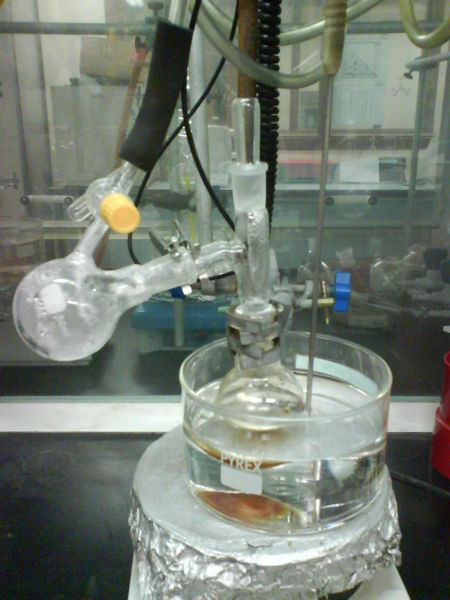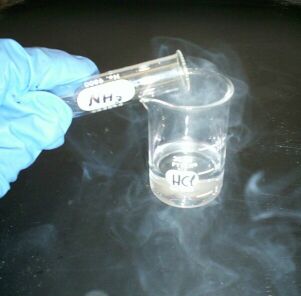|
Brønsted–Lowry Acid–base Theory
The Brønsted–Lowry theory (also called proton theory of acids and bases) is an acid–base reaction theory which was developed independently in 1923 by physical chemists Johannes Nicolaus Brønsted (in Denmark) and Thomas Martin Lowry (in the United Kingdom). The basic concept of this theory is that when an acid and a base react with each other, the acid forms its conjugate base, and the base forms its conjugate acid by exchange of a proton (the hydrogen cation, or H+). This theory generalises the Arrhenius theory. Definitions of acids and bases In the Arrhenius theory, acids are defined as substances that dissociate in aqueous solutions to give H+ ( hydrogen cations or protons), while bases are defined as substances that dissociate in aqueous solutions to give OH− (hydroxide ions). In 1923, physical chemists Johannes Nicolaus Brønsted in Denmark and Thomas Martin Lowry in England both independently proposed the theory named after them. In the Brønsted–Lowry ... [...More Info...] [...Related Items...] OR: [Wikipedia] [Google] [Baidu] |
Acid–base Reaction
In chemistry, an acid–base reaction is a chemical reaction that occurs between an acid and a base. It can be used to determine pH via titration. Several theoretical frameworks provide alternative conceptions of the reaction mechanisms and their application in solving related problems; these are called the acid–base theories, for example, Brønsted–Lowry acid–base theory. Their importance becomes apparent in analyzing acid–base reactions for gaseous or liquid species, or when acid or base character may be somewhat less apparent. The first of these concepts was provided by the French chemist Antoine Lavoisier, around 1776. – Table of discoveries attributes Antoine Lavoisier as the first to posit a scientific theory in relation to oxyacids. It is important to think of the acid–base reaction models as theories that complement each other. For example, the current Lewis model has the broadest definition of what an acid and base are, with the Brønsted–Lowry the ... [...More Info...] [...Related Items...] OR: [Wikipedia] [Google] [Baidu] |
Acetonitrile
Acetonitrile, often abbreviated MeCN (methyl cyanide), is the chemical compound with the formula and structure . This colourless liquid is the simplest organic nitrile (hydrogen cyanide is a simpler nitrile, but the cyanide anion is not classed as organic). It is produced mainly as a byproduct of acrylonitrile manufacture. It is used as a polar aprotic solvent in organic synthesis and in the purification of butadiene. The skeleton is linear with a short distance of 1.16 Å. Acetonitrile was first prepared in 1847 by the French chemist Jean-Baptiste Dumas. Applications Acetonitrile is used mainly as a solvent in the purification of butadiene in refineries. Specifically, acetonitrile is fed into the top of a distillation column filled with hydrocarbons including butadiene, and as the acetonitrile falls down through the column, it absorbs the butadiene which is then sent from the bottom of the tower to a second separating tower. Heat is then employed in the separa ... [...More Info...] [...Related Items...] OR: [Wikipedia] [Google] [Baidu] |
Dimethylsulfoxide
Dimethyl sulfoxide (DMSO) is an organosulfur compound with the formula . This colorless liquid is the sulfoxide most widely used commercially. It is an important polar aprotic solvent that dissolves both polar and nonpolar compounds and is miscible in a wide range of organic solvents as well as water. It has a relatively high boiling point. DMSO is metabolised to compounds that leave a garlic-like taste in the mouth after DMSO is absorbed by skin. In terms of chemical structure, the molecule has idealized Cs symmetry Symmetry () in everyday life refers to a sense of harmonious and beautiful proportion and balance. In mathematics, the term has a more precise definition and is usually used to refer to an object that is Invariant (mathematics), invariant und .... It has a trigonal pyramidal molecular geometry consistent with other three-coordinate S(IV) compounds, with a lone pair, nonbonded electron pair on the approximately Tetrahedral molecular geometry, tetrahedral sul ... [...More Info...] [...Related Items...] OR: [Wikipedia] [Google] [Baidu] |
Azanide
Azanide is the IUPAC-sanctioned name for the anion . The term is obscure; derivatives of are almost invariably referred to as amides, despite the fact that amide also refers to the Organic chemistry, organic functional group –. The anion is the conjugate base of ammonia, so it is formed by Ammonia#Self-dissociation, the self-ionization of ammonia. It is produced by deprotonation of ammonia, usually with strong bases or an alkali metal. Azanide has a H–N–H bond angle of 104.5°. Alkali metal derivatives The alkali metal derivatives are best known, although usually referred to as alkali metal amides. Examples include lithium amide, sodium amide, and potassium amide. These salt-like solids are produced by treating liquid ammonia with strong bases or directly with the alkali metals (blue liquid ammonia solutions due to the solvated electron): :, where M = Li, Na, K Silver(I) amide () is prepared similarly. Transition metal complexes of the amido ligand are often produced by ... [...More Info...] [...Related Items...] OR: [Wikipedia] [Google] [Baidu] |
Ammonium Salt
Ammonium is a modified form of ammonia that has an extra hydrogen atom. It is a positively charged (cationic) molecular ion with the chemical formula or . It is formed by the addition of a proton (a hydrogen nucleus) to ammonia (). Ammonium is also a general name for positively charged (protonated) substituted amines and quaternary ammonium cations (), where one or more hydrogen atoms are replaced by organic or other groups (indicated by R). Not only is ammonium a source of nitrogen and a key metabolite for many living organisms, but it is an integral part of the global nitrogen cycle. As such, human impact in recent years could have an effect on the biological communities that depend on it. Acid–base properties The ammonium ion is generated when ammonia, a weak base, reacts with Brønsted acids (proton donors): : The ammonium ion is mildly acidic, reacting with Brønsted bases to return to the uncharged ammonia molecule: : Thus, the treatment of concentrated solutio ... [...More Info...] [...Related Items...] OR: [Wikipedia] [Google] [Baidu] |
Liquid Ammonia
Ammonia is an inorganic chemical compound of nitrogen and hydrogen with the formula . A stable binary hydride and the simplest pnictogen hydride, ammonia is a colourless gas with a distinctive pungent smell. It is widely used in fertilizers, refrigerants, explosives, cleaning agents, and is a precursor for numeous chemicals. Biologically, it is a common nitrogenous waste, and it contributes significantly to the nutritional needs of terrestrial organisms by serving as a precursor to fertilisers. Around 70% of ammonia produced industrially is used to make fertilisers in various forms and composition, such as urea and diammonium phosphate. Ammonia in pure form is also applied directly into the soil. Ammonia, either directly or indirectly, is also a building block for the synthesis of many chemicals. In many countries, it is classified as an extremely hazardous substance. Ammonia is toxic, causing damage to cells and tissues. For this reason it is excreted by most animals in th ... [...More Info...] [...Related Items...] OR: [Wikipedia] [Google] [Baidu] |
Analogy
Analogy is a comparison or correspondence between two things (or two groups of things) because of a third element that they are considered to share. In logic, it is an inference or an argument from one particular to another particular, as opposed to deduction, induction, and abduction. It is also used where at least one of the premises, or the conclusion, is general rather than particular in nature. It has the general form ''A is to B as C is to D''. In a broader sense, analogical reasoning is a cognitive process of transferring some information or meaning of a particular subject (the analog, or source) onto another (the target); and also the linguistic expression corresponding to such a process. The term analogy can also refer to the relation between the source and the target themselves, which is often (though not always) a similarity, as in the biological notion of analogy. Analogy plays a significant role in human thought processes. It has been argued that analogy li ... [...More Info...] [...Related Items...] OR: [Wikipedia] [Google] [Baidu] |
Autoionization Of Water
The self-ionization of water (also autoionization of water, autoprotolysis of water, autodissociation of water, or simply dissociation of water) is an ionization reaction in pure water or in an aqueous solution, in which a water molecule, H2O, deprotonates (loses the nucleus of one of its hydrogen atoms) to become a hydroxide ion, OH−. The hydrogen nucleus, H+, immediately protonates another water molecule to form a hydronium cation, H3O+. It is an example of autoprotolysis, and exemplifies the amphoteric nature of water. History and notation The self-ionization of water was first proposed in 1884 by Svante Arrhenius as part of the theory of ionic dissociation which he proposed to explain the conductivity of electrolytes including water. Arrhenius wrote the self-ionization as H2O H+ + OH-. At that time, nothing was yet known of atomic structure or subatomic particles, so he had no reason to consider the formation of an H+ ion from a hydrogen atom on electrolysis as any les ... [...More Info...] [...Related Items...] OR: [Wikipedia] [Google] [Baidu] |
Aluminium Hydroxide
Aluminium hydroxide, , is found as the mineral gibbsite (also known as hydrargillite) and its three much rarer polymorphs: bayerite, doyleite, and nordstrandite. Aluminium hydroxide is amphoteric, i.e., it has both basic and acidic properties. Closely related are aluminium oxide hydroxide, AlO(OH), and aluminium oxide or alumina (), the latter of which is also amphoteric. These compounds together are the major components of the aluminium ore bauxite. Aluminium hydroxide also forms a gelatinous precipitate in water. Structure is built up of double layers of hydroxyl groups with aluminium ions occupying two-thirds of the octahedral holes between the two layers. Four polymorphs are recognized. All feature layers of octahedral aluminium hydroxide units, with hydrogen bonds between the layers. The polymorphs differ in terms of the stacking of the layers. All forms of crystals are hexagonal : * gibbsite is also known as γ- or α- * bayerite is also known as α- or ''β ... [...More Info...] [...Related Items...] OR: [Wikipedia] [Google] [Baidu] |
Amphoteric
In chemistry, an amphoteric compound () is a molecule or ion that can react both as an acid and as a base. What exactly this can mean depends on which definitions of acids and bases are being used. Etymology and terminology Amphoteric is derived from the Greek word () meaning "both". Related words in acid-base chemistry are amphichromatic and amphichroic, both describing substances such as acid-base indicators which give one colour on reaction with an acid and another colour on reaction with a base. Amphiprotism Amphiprotism is exhibited by compounds with both Brønsted acidic and basic properties. A prime example is H2O. Amphiprotic molecules can either donate or accept a proton (). Amino acids (and proteins) are amphiprotic molecules because of their amine () and carboxylic acid () groups. Ampholytes Ampholytes are zwitterions ‒ molecules or ions that contain both acidic and basic functional groups. Amino acids have both a basic group and an acidic group . Of ... [...More Info...] [...Related Items...] OR: [Wikipedia] [Google] [Baidu] |




